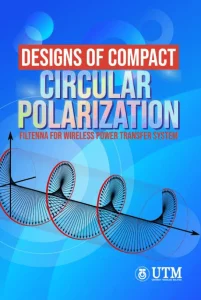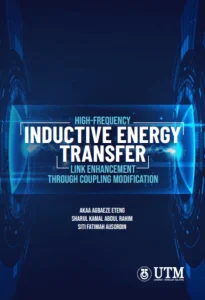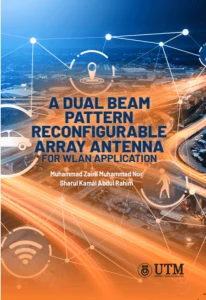Book Title : Flexible Materials for Ultra Wideband Antenna Design
2023

Author
Husameldin Abdelrahman Elmobarak, Sharul Kamal Abdul Rahim, Nor Aishah Muhammad & Siti Fatimah Ausordin
Description
This book presents the methods to integrate flexible conductive materials into flexible dielectric materials for fabricating transparent ultra-wideband (UWB) antennas and polymer matrix composite (PMC) antennas. Generally, UWB systems require the antenna with high efficiency, however, maintaining a high efficiency while achieving extremely wide bandwidth in a UWB system is a challenging task. Therefore, conduction and dielectric losses should be minimized in UWB antenna using highly conductive materials and low dielectric loss materials. Metals are commonly used as antenna radiating elements because of their high conductivity. However, the poor mechanical flexibility of the metals can limit their use for flexible and conformal applications. The question arises if non-metallic flexible conductive materials having conductivity close to metals can be integrated into the flexible dielectric materials to replace metals. This can be solved by integrating flexible conductive materials into flexible dielectric materials. The development of flexible transparent UWB antennas and flexible PMC composite UWB antennas are thoroughly discussed in detail in this book.
Book Title: Design of Compact Circular Polarization Filtennafor Wireless Transfer System
2023

Author
Mursyidul Idzam Sabran, Sharul Kamal Abdul Rahim & Siti Fatimah Ausordin
Description
The book focuses on the design of a compact and miniature RF front-end structure operating within a 2.45 GHz unlicensed ISM band for WPT applications. WPT components are composed of five essential elements: antenna, pre-filter, rectifier, post-filter and load. Emphasis will be given only on designing the antenna and filter towards the compactness feature for the WPT application. Several selected design methods are used to achieve compactness with acceptable performances. The chosen approaches are studied to occupy the compact antenna and filter structures. The proposed antennas and filters are simulated and optimized using Computer Simulation Technology (CST) based on the required performances. The optimum design is fabricated and measured in terms of the S11, radiation pattern, gain and AR.
Book Title: Sustainable Power Efficiency for Non-Radiative Inductive Printed Spiral Coil
2022

Author
Laily Pon & Sharul Kamal Abdul Rahim
Description
Sustainable mobility is a common term used for electric automobile applications involving dynamic charging mode instead of conventional stationary charging when vehicle remains static (Bi et al., 2016). There are compromises in assessing sustainability since reduction of battery size and weight as well as fuel economy enhancement comes with deployment of massive wireless charging infrastructure. Similarly, for low power wireless energy transfer (WET) applications namely wireless charging for consumer electronics and biomedical implants, there is a trade-off in achieving sustainable power transfer efficiency (PTE) between advantages of random receiver’s positioning as opposed to considerable size of transmitter and receiver apart from other pertinent supplementary intermediate elements.
This gives rise to an indispensable consideration in developing a pair of non-radiative inductive Printed Spiral Coils (PSC) with regards to sustaining PTE over various positions and downsizing overall size requirements of both transmitting and receiving PSCs. Etched on a substrate, conventional PSC is constructed based on homogenous distribution of conductor’s width and spacing between conductive traces. Variable spacing between turns reported in (Sharma et al., 2013b), (Akaa Agbaeze Eteng, Abdul Rahim, Leow, et al., 2016) yield significant implications towards PTE enhancement at fixed transfer distance. This book describes the application of meticulous geometrical layout manipulation resulting in inhomogeneous conductor’s width and spacing between turns of compact PSC structure for both external and synthesized capacitive compensationnetwork (CCN) towards conservation of PTE.
Book Title: High-Frequency Inductive Energy Transfer: Link Enhancement Through Coupling Modification
2022

Author
Akaa Agbee Eteng, Sharul Kamal Abdul Rahim & Siti Fatimah Ausordin
Description
A paucity of broad methodologies for designing inductive energy transfer links has led to the utilization of proprietary and non-interoperable link performance enhancements. The original contribution of this book is the development of general coupling-based design methods to improve the energy transfer performance of high-frequency inductive links. First, the book develops a general procedure to improve the transfer efficiency of symmetric inductive links established using axially-aligned printed spiral coils (PSCs), which are externally constrained by an upper-quality factor bound. The procedure compensates for low PSC quality factors by geometrically improving PSC coupling potentials. The application of the method in a test scenario led to the enhancement of the link transfer efficiency and augmented the link fractional bandwidth without altering the PSC quality factors. Secondly, the book proposes an unobtrusive method for ensuring uniform link transfer efficiency under various degrees of partial lateral misalignment between coupled PSC terminals. The method functions by ensuring that the link operates within an over-coupled regime, irrespective of the alignment conditions. Testing the developed procedure in a design scenario led to a reduction in the range of transfer efficiency values. Finally, a PSC-design technique to enable fixed-matched inductive links to maintain a near constant performance level for distances within a designated operational range. The method is based on seeking to maintain link critical coupling despite having PSC separation distances closer than the designated link range.
Book Title: A Dual Beam Pattern Reconfigurable Array Antenna For WLAN Application
2022

Author
Muhammad Zairil Muhammad Nor & Sharul Kamal Abdul Rahim
Description
Antenna reconfigurability features can allow an antenna to make selection and advancement in their operating frequency, polarization, radiation patterns, and gain. The integration of RF switches in the antenna, the reconfigurable antenna allows reconfigurable antenna used in modern wireless applications. In switched-beam reconfigurable antennas, the limitation of conventional antenna which is only able to radiate their radiation pattern at one specific location can be overcome as this type of antenna can switch their main beam at several location by controlling the configuration of their RF switches.
This book describes on the development of a switched-beam reconfigurable antenna by using PIN diodes. There are three phases on developing proposed switched-beam antenna where initiate with development of broad-forward beam printed monopole antenna using FR4 material. Then, the development of patch antenna with defected parabolic ground plane structure has been design in improving the directivity properties of proposed antenna. Lastly, the development of proposed switched-beam reconfigurable antenna where the previous developed antenna will be combined together in array configuration by using parallel strip transmission line technique and implementation of RF switches (PIN diodes) is adapted to transform the proposed antenna into reconfigurable antenna.
Book Title : Active Antenna Beamforming Networks Using Butler Matrices
2020

Author
Sharul Kamal Abdul Rahim
Description
This book presents the advantages of having Butler Matrices in a receiver system integrated with Low Noise Amplifiers (LNAs). The performances of array antennas with and without LNAs and with and without Butler Matrix are evaluated in terms of measured signal to noise ratio (SNR) at each output port. The SNR values are combined to evaluate the diversity gains available with diversity combining techniques.
By using narrow beams available from the Butler Matrix, it is possible for a receiver to increase the gain in the desired signal directions and reduce the gain in interference directions. Hence, high-gain narrow beam signals for long-range application are produced. A novel technique is introduced which uses high linearity LNAs and a second Butler Matrix, acting as a mirror of the first Butler Matrix, reconstructing the antenna patterns of the individual radiating elements.
The resulting outputs have high linearity and broad beam width that can be used for short-range communications. This book provides a method which could be applicable in vehicle communication systems, where long-range communications with roadside beacons and short-range communications with a fast moving vehicle are both required.

